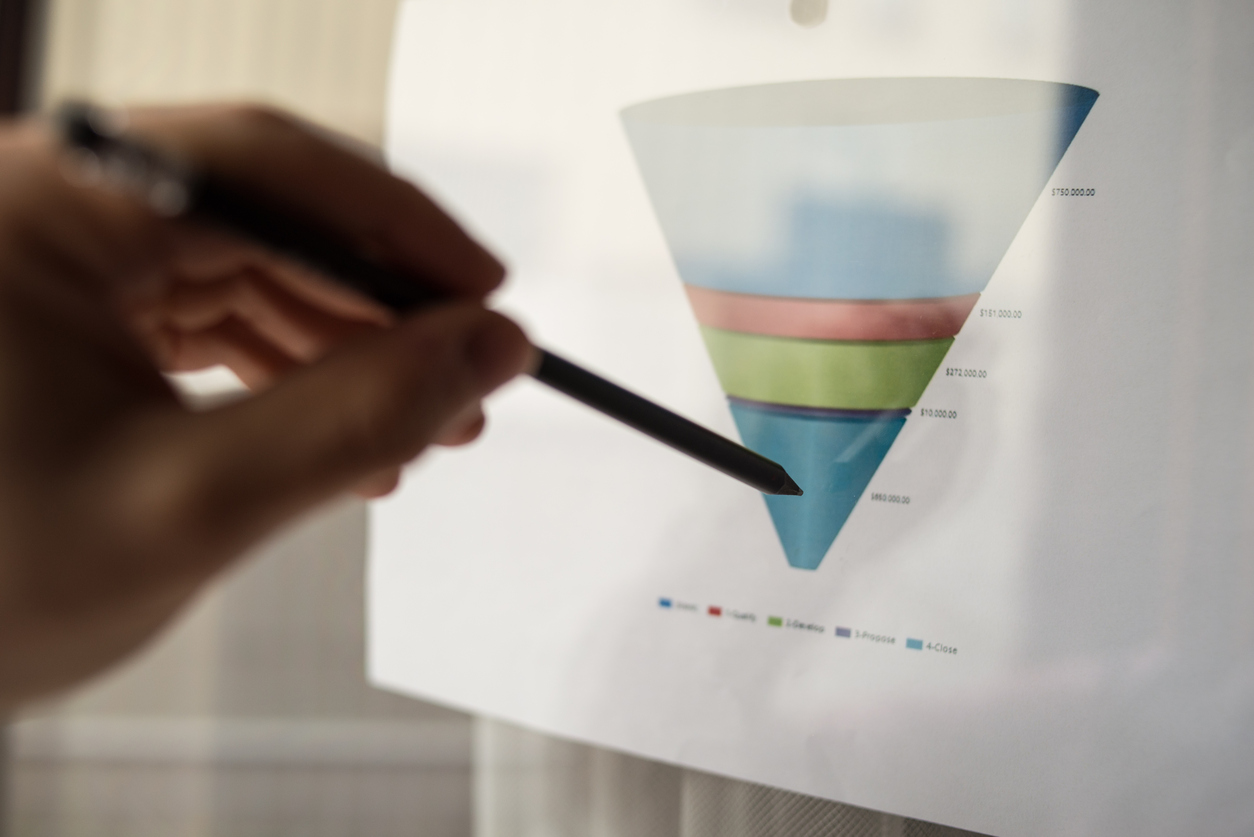The marketing funnel isn’t a brand new concept in the marketing world, but it’s also not an extensively discussed topic commonly floating around in front-line sales. Instead, it’s a high-concept idea used by marketers to describe the overall process of converting a potential buyer into a consumer. But why exactly is it a “funnel,” instead of a sphere, a cylinder, or even a straight line? And what is it about the marketing funnel that makes it unique from other perspectives?
Let’s get back to basics and review the fundamentals of market funnels, how they work, how they flow, and how you should interact with them for the greater good.
Marketing Funnel Fundamentals
Market funnels are divided into a few specific parts. Potential consumers navigate through each step, but not all of them make it through the entire process. Some last just a single step, while others stick with it almost to the end before dropping off. Fewer prospects reach the end and make the purchase, hence the funnel shape being an accurate representation of the number of consumers who make it to each step.
Awareness
Awareness is naturally the first step of every effective funnel. Consumers need to know about your product before they can purchase it; that’s why much of the time and energy used in marketing campaigns is spent on increasing awareness and reach. Trade shows, viral marketing, events, advertisement, and social media marketing are just a few methods commonly used to draw in buyers and keep their attention Consumer research to increase potential prospects also falls into this stage of the funnel.
Interest
Once a potential customer is aware of your product, either through advertisement or other lead generation strategies, they shift into the interest stage. This is the point where they begin to learn more about the company and its services. At around this stage, most begin researching what your company is about and who it really is, including your goals.
Modern consumers are more readily influenced by this information, and are much more likely to drop out of the funnel if they disagree with who you are or what you stand for, even if they love the products you sell. At this stage, you should focus on informing the prospects about how your company is different and how they can benefit from your products.
Consideration
When a lead is sufficiently interested, they’ll move into the consideration phase. You’ve got them hooked, so now it’s time to get them to bite. Make an effort to know your prospect, continue to inform them of your services, and target your content towards them. Free trials and automated emails are effective tools to use at this part of the funnel.
Intent to Purchase
Intent to purchase is the next step for the lead. Your prospects may intend to make a purchase after a seeing product demonstration or telling you through a survey. Placing an item in an online shopping cart also counts as intent. Don’t assume this automatically means they’ll follow through; this is also a high-risk position for exiting the funnel. The key is to give them a great reason to follow through with their gut instincts.
Evaluation
Customers will then move to evaluation. They’re debating going with your product before pulling the trigger. Maybe they’re comparing it to your competitors or playing out the scenario in their head where they make a purchase. You may need to provide the prospect with a little more incentive and convince them why your product is right for them.
Making the Sale
Finally, all of your hard work has paid off: they buy the product. The prospect has turned into a customer. Now, you need to focus on finalizing the details with them and impressing them with your super-suave customer service skills.
Remember, your new customer may recommend your services to others if they have a positive and memorable experience with your sales reps. Recommendations and customer advocates are highly desirable and are a key part of modern marketing. Some companies are “flipping the funnel” by spending more time turning customers into advocates to increase their reach.
Marketing Funnels vs. Sales Funnels
The market funnel has remained as a quintessential concept in the industry for decades. Its structure still largely holds up to conventional practices, but technology is starting to change its shape because of influences like influencers (pun intended) and social media websites. There are also some important differences in how the funnel operates depending on the type of consumer.
The amount of advisors differs greatly between B2B and B2C consumers. B2C consumers generally have a smaller pool of people they turn to for advice on a product or service; in fact, they may even make decisions solely by themselves. Typically, it’s their friends and family giving feedback when they do seek advice. They’re also much more likely to turn to the Internet for advice, especially from influencers.
B2B consumers have a larger pool of advisors, often in other departments (like finance or accounts payable). Their buying process is more nuanced and involves 5.4 people on average. Each of these individuals may need to approve or sign off on purchases, meaning salespeople can’t just convince one person to buy. They may need to use a team approach instead.
Company representatives also generally don’t interact with each group the same way. B2C consumers rarely encounter a representative; this is even less true on e-commerce outlets. B2B buyers rely on the representative to see the purchase through, especially with the ending stages of the funnel.
Some marketing experts are making the argument that the funnel is obsolete. Their claim is the buying process is far less linear than it was in the past. Whether or not that’s true depends on who you ask.
Increased availability of information is changing the way consumers make their decisions. Many leads are entering the funnel process at stages different from previous generations, basing more decisions on individual research.
A potential buyer might enter your funnel at the intent stage, rather than the awareness stage, skipping the first few steps. They may have extensively informed themselves about the product they want, and the next step for them is determining which brand meets their needs. Research shows that 57 percent of the funnel is skipped by B2B buyers before they interact with a company representative.
Battle of the Fittest Funnel
One of the hot topics in the marketing industry is who really owns the market funnel. The rise of information accessibility and interactivity is changing how the funnel works. There are compelling cases for both the marketing team owning the funnel or a mixture of the marketing and sales departments.
Marketers claim that consumers heavily depend on digital content to inform their purchasing process and that dependency is increasing. The marketing team feels like they have more control over who enters the funnel and where they enter it. They try to spend more time nurturing relationships with potential buyers and guide them through the funnel.
The sales department sees things differently. They believe ownership is more of a vertical split because sales reps are becoming more important over time. Modern company reps do more to promote awareness and contribute to the thought processes that drive up sales than before. They believe the way to increase sales volume is to have the marketing and sales departments working more closely.
Overall, the market funnel is an easy way to visualize the reality of how many leads turn into buyers. Its shape may change over the next few decades as technology changes the way consumers operate, but don’t worry about it disappearing. Increased access to information doesn’t necessarily make the funnel obsolete, so it’s still a great tool to use when analyzing your marketing potential.
President and founder of DVI, Aaron Boerger realized early in life that he had a unique combination of x-ray vision and business acumen for seeing the weaknesses that held businesses back – and the ability to define the right tools, technology and strategy to make them stronger.
From founding a successful technology support business in his early teens, to serving as Chief Operating Officer for several companies in the financial, technology and marketing industries, Aaron has developed a reputation for reinventing technology implementation tactics – and the willingness to tell people not what they want to hear, but what they need to hear, in order to achieve success without overwhelm.
Aaron will always go the extra mile to provide the accountability and support his clients need to achieve their goals, yet isn’t afraid to tell them when they are doing something wrong.

